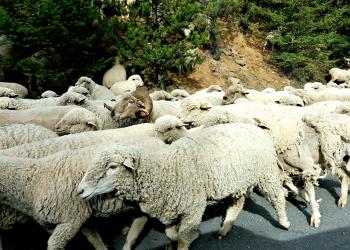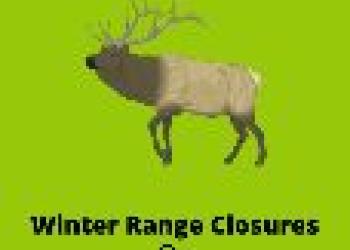Safety and Outdoor Ethics
Safety tip: All forest visitors are encouraged to notify family or friends of their trip itinerary including their expected return schedule. It is common for weather conditions to change suddenly in mountainous terrains; sunny mornings can turn into stormy afternoons. Always be prepared for bad weather. Remember you can't count on cell phone coverage in remote areas!
The 10 essentials you should carry include:
- Navigation: Map, altimeter, compass, [GPS device], [PLB or satellite communicators], [extra batteries or battery pack] (*Don't rely solely on a mobile device for navigation.)
- Headlamp/flashlight with extra batteries.
- Fire: Matches, candle or firestarter - make sure matches are protected.
- Knife: plus any repair kit
- First aid: carry items that take care of blisters, headaches, foot care, insect repellent etc.
- Sun protection: glasses, sunscreen, sun protective clothing
- Emergency items: light shelter, mirror and whistle.
- Extra clothing: Raingear and non-cotton layers.
- Extra water: at least one quart, means to purify
- Extra food: high energy snack such as chocolate, jerky or protein bars.
Visitor Guidelines and Frequently Asked Questions
Trash and Camp Waste
Always PACK IT OUT! Please leave your campsite or fire ring cleaner than when you found it.
Camping
- Many campgrounds have sites you can reserve in advance at Recreation.gov. All campgrounds have at least some sites that are first-come, first-served.
- Most campgrounds accommodate trailers, but none have electricity.
- Campgrounds open after snow has melted, down limbs are cleared, and water systems have been tested for safety. They generally close between early September and mid-October.
Dispersed Camping (camping outside of a designated campground):
- Locate your camping spot outside of fragile meadows and restricted areas, preferably on bare or mineral soil.
- Camp out of view from major roads and trails, where possible.
- Camping at least 100 feet from the shoreline of lakes and streams will help protect plants and animals that use these areas.
- Avoid trenching around sleeping areas by selecting a site with good natural drainage.
- Cutting boughs from trees for a bed is not an acceptable practice.
- Be prepared to always pack out all trash and objects you brought with you! Leave your camp area cleaner than when you found it.
- Bury human waste 100 feet from water sources and at least 6 inches deep.
- Follow Leave No Trace principles.
Campfires:
- Check for fire restrictions before heading out.
- If you must have a fire, use an existing fire ring.
- If a fire ring is not available, build it small, in a safe place, cleared down to dirt, away from overhanging branches. Remove the upper layers of organic soil (decayed leaves, plants, etc.) and save this soil for covering up the fire scar.
- Gather only dead and down wood for your fire. Never cut (or nail into) live trees. (Remember: A firewood permit is required to remove wood from the forest.)
- You should have a bucket and a shovel to extinguish your fire.
- Put out campfires by drowning them, stirring them with dirt, and drowning again. Ashes & charcoal should be cool to the touch.
- Never leave a fire unattended.
- Do not smoke while walking through the forest. Smokers should stop, clear a space to dirt, and smoke in the cleared area.
- Report any wildfire you see to any Forest Service employee, sheriff's deputy, or telephone operator.
Human Waste
If there are no toilets available, choose a suitable, screened spot at least 200 feet from any stream or lake. Dig a small hole about 6 inches deep by 8 inches in diameter. After use, fill the hole with soil and replace the duff. This allows the waste to decompose naturally. Bury toilet paper in the same hole. Empty built-in or portable toilets at sanitary dump stations.
Drinking Water
Streams and lakes are home to many microscopic organisms- some of them can make you sick. Treat your water or bring water from home. Never clean dishes or fish in a stream or lake. Safe drinking water supplies are only maintained at recreation sites with developed water systems.
Stock Use
Several campgrounds are designed for stock use. These "horse camps" are located on or near horse trails.
- Please use high picket line with tree padding when corrals or tie stalls are not available.
- Disperse manure into native vegetation or provided receptacle.
- Hobble animals that paw and practice "leave no trace" camping.
- Horses are only permitted in designated horse camps.
- Keep pack or saddle stock at least 200 feet from any lake or stream, except for watering, loading, unloading, or traveling on established trail routes.
- Forage may be limited, so you should carry certified weed-free feed.
- Avoid tying stock to trees at campsites for prolonged periods.
Fishing and Hunting
The Oregon Department of Fish and Wildlife sets seasons and possession limits. An Oregon State license is required to hunt or fish in the Forest and Grassland. Please consult current regulations prior to fishing or hunting.
Forest Products (mushrooms, berries, foliage, transplants, etc.)
In addition to the harvest of trees that provide lumber and other wood products, many other products are harvested, such as cones, evergreen boughs, Christmas trees, mushrooms, firewood, and common minerals.
The harvest of forest products usually requires a permit for both personal and commercial uses. Permits allow the Forest Service to monitor the demand and use of various products to ensure that areas are not overused. Please check for the permits you will need before removing anything from the Forest or Grassland.
Tread Lightly
- Travel only where motorized vehicles are permitted and drive responsibly.
- Respect the rights of hikers, horseback riders, skiers, campers and others so they can enjoy their activities undisturbed.
- Get visitor maps and regulations from public agencies, comply with signs and barriers, and ask owners' permission to cross private property.
- Avoid streams, lakeshores, meadows, muddy roads and trails, steep hillsides, wildlife and livestock.
- Learn more about Tread Lightly: https://treadlightly.org.
Safe Driving Tips
- Drive at a reasonable speed. Most forest roads are not designed for high speeds.
- Many forest roads are one-lane wide. On curves, keep to the right and use turnouts to allow oncoming vehicles to pass. Please do not block turnouts or use them for an "extended" stop.
- Your line of sight is often obstructed by trees, brush, hills, or sharp curves, and your vehicle cannot stop as quickly on gravel or dirt surfaces as on paved streets. Watch for wildlife.
- Use a vehicle that is suitable for rough travel and carry extra supplies. Take adequate clothing along with you, and let someone know where you are going and when you expect to return.
- Forest roads are not maintained for winter travel. Respect your vehicle's limitations. Don't count on cell service.
- Log trucks and logging activities may be encountered at any time, even on weekends. Be alert!
- Carry printed version of the forest Motor Vehicle Use Map. It's free and available for your smartphone as well.
Why is this Road Closed?
There are a number of reasons some modes of travel are restricted within National Forests. These are not always well understood, particularly if encountered unexpectedly. Here are some reasons for them:
Wildlife Habitat Protection -- Many closures are put into effect to protect critical areas where big-game animals live. These areas are sensitive and often include winter ranges, calving grounds, or security areas. These same areas are often open to vehicle use during other times of the year when big game are less likely to be disturbed.
Water Quality and Erosion Control -- Some roads and trails are closed during wet weather to prevent rutting and other roadbed damage. This reduces erosion and the amount of sediment that can be transported to streams. Sediment is a serious threat to spawning and rearing grounds for steelhead, salmon, and other fish.
Public Safety -- In some specific instances, certain types of travel are prohibited to ensure user safety. Even so, caution should be used on every Forest route.
Recreation -- One goal on the Ochoco National Forest and Crooked River National Grassland is to provide a broad range of recreation settings and opportunities. Some areas of the Forest and Grassland are designated for nonmotorized recreation to achieve a balance with motorized recreation opportunities.
Safety Tips for Burned Areas
Hikers ALWAYS assume risks when entering trails in natural areas, but in burned areas those risks are greater. Your safety is in your hands!
Winter Safety
Winter recreation is popular on the Ochoco National National Forest & Crooked River National Grassland. Please review safety tips and regulations before you go. Be prepared and know your limits.
Hiking During Hunting Season
Hunting is allowed across most of the Ochoco National National Forest & Crooked River National Grassland. Learn more about how you and your family can stay safe while out on trails and campsites during hunting season from our patners at Washington Trails Association.
Wildlife
Cougars, bears, and other large mammals are some of the wildlife that call the Cascade Range home. Learn more about these animals and how to share the forest safely. Remember to NEVER feed wildlife, help keep wildlife wild.
Learn more about visiting and recreating in bear country from Oregon Department of Fish and Wildlife.
Learn more about cougars and safety from Oregon Department of Fish and Wildlife.
Weed-Free Feed
Learn more about weed-free feed and requirements.
Recreation Tips in Rangeland

The following guidelines will help you have a positive recreation experience and minimize the potential for conflicts with grazing activities on the National Forest.
Winter Range Closures

Winter range closures are in effect December 1 through May 1. Motorized vehicles are prohibited in the closure areas to protect deer and elk during the winter.


